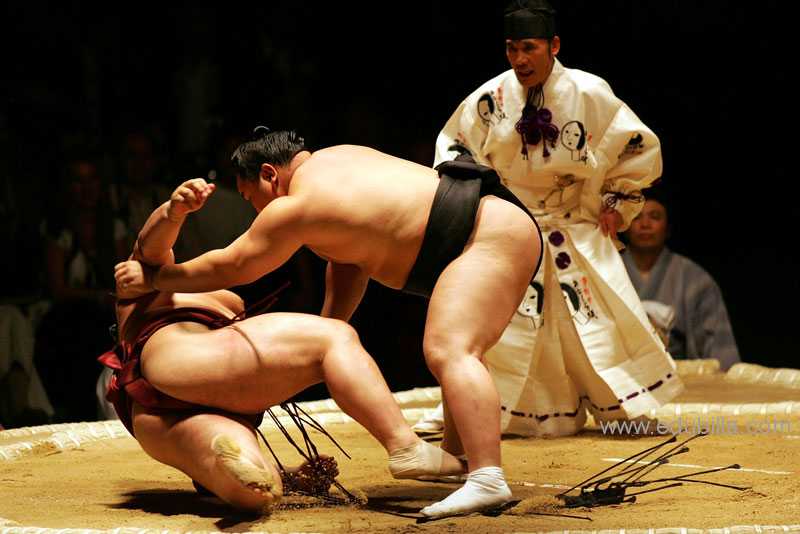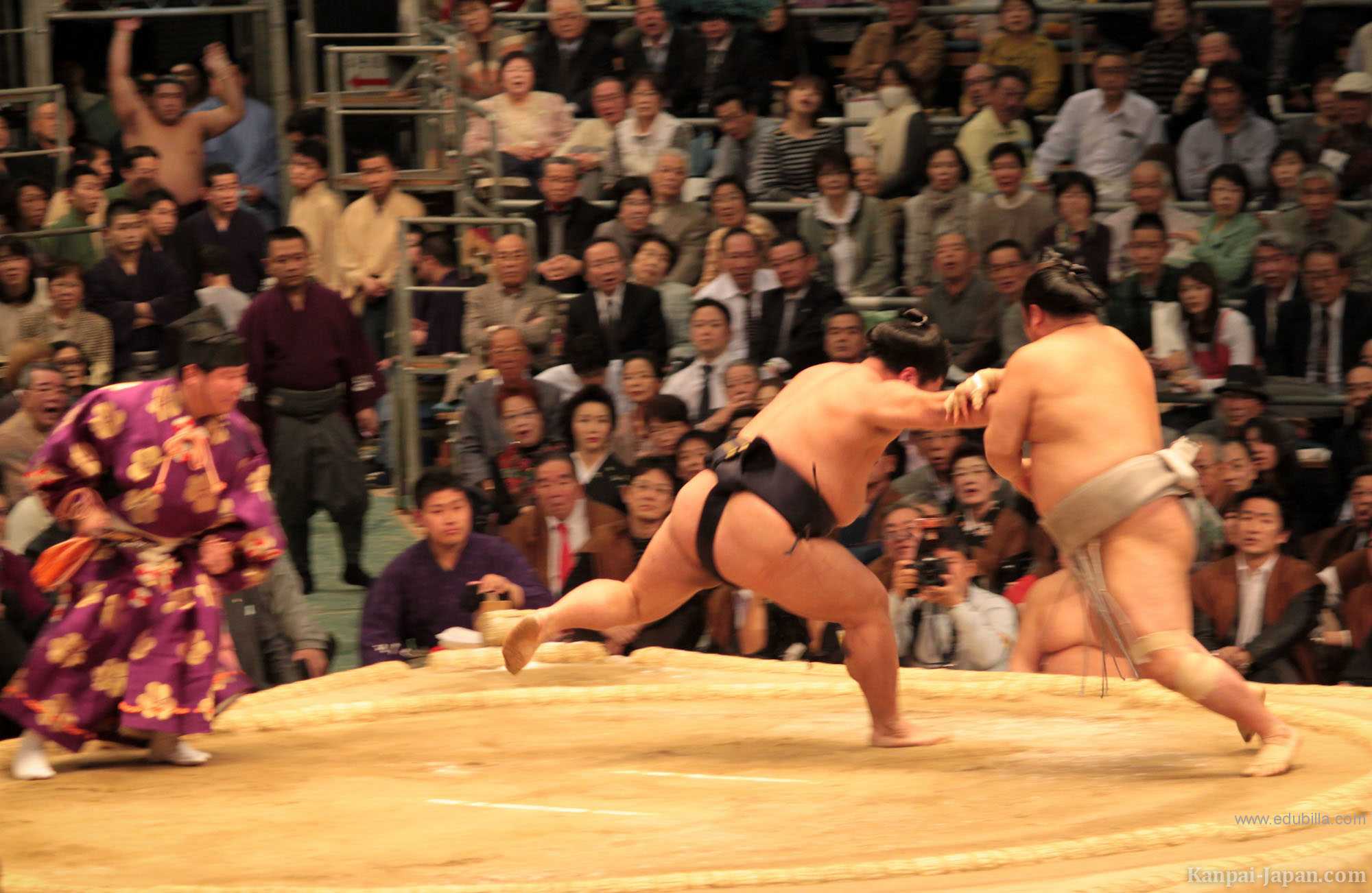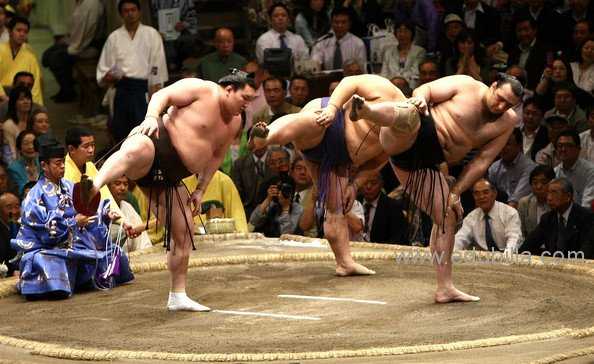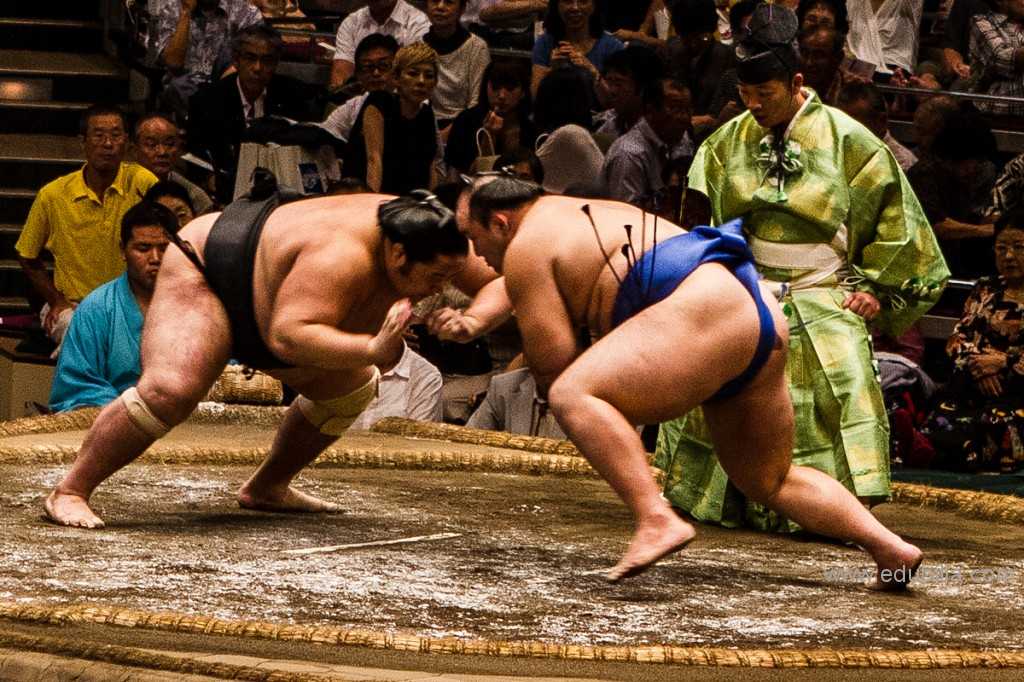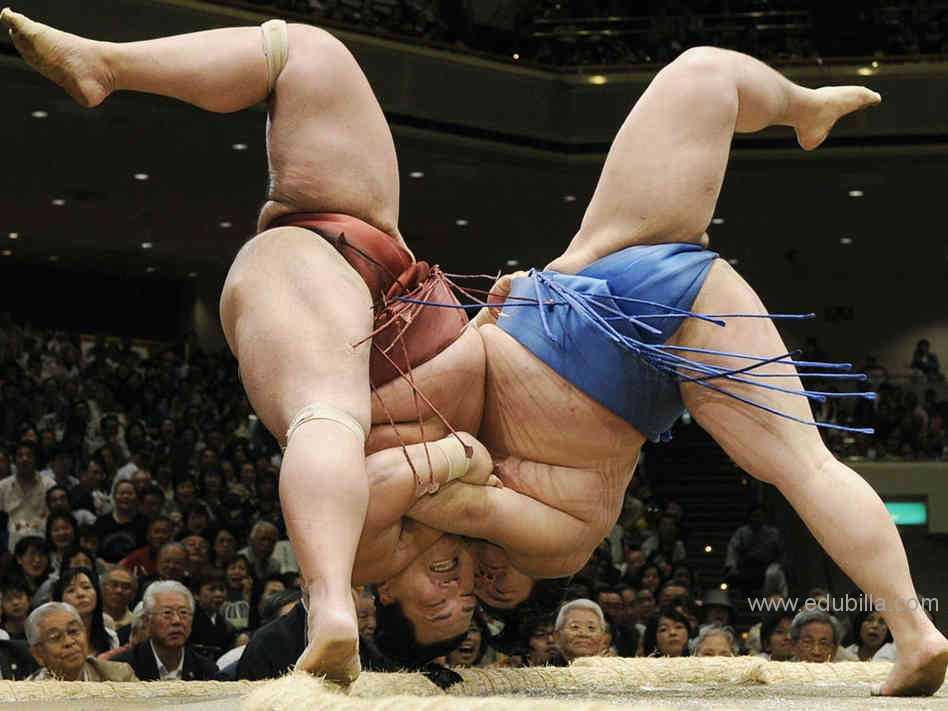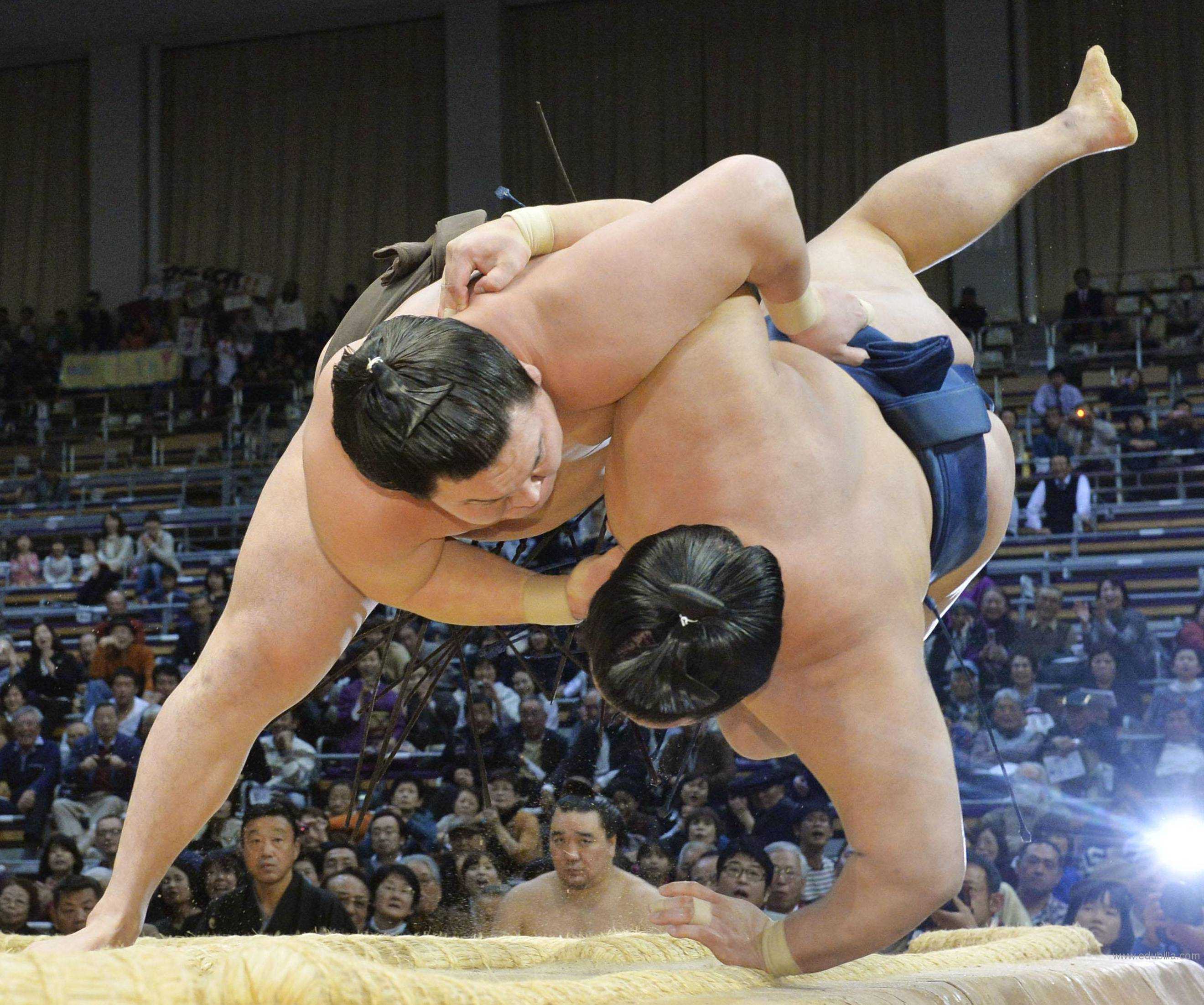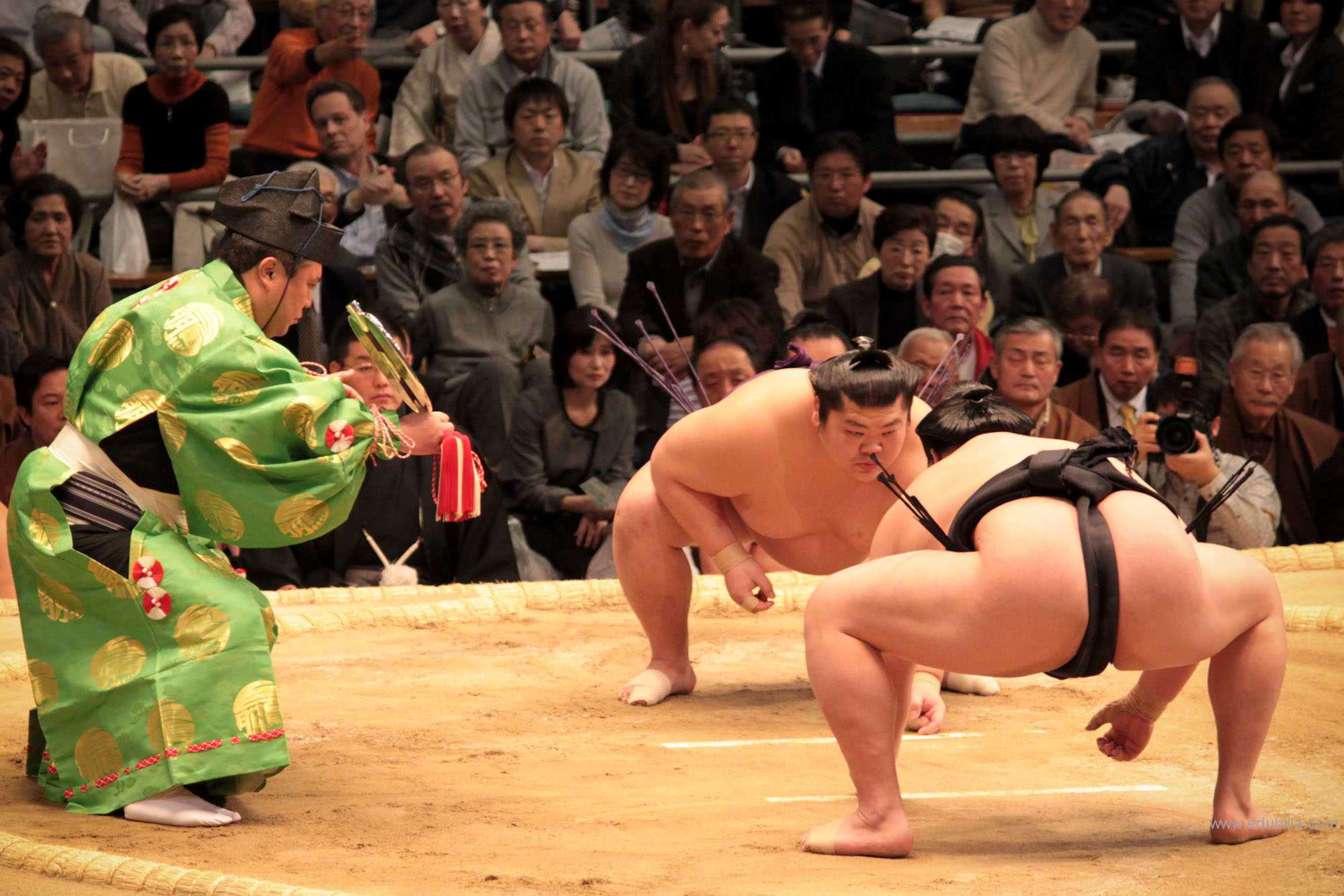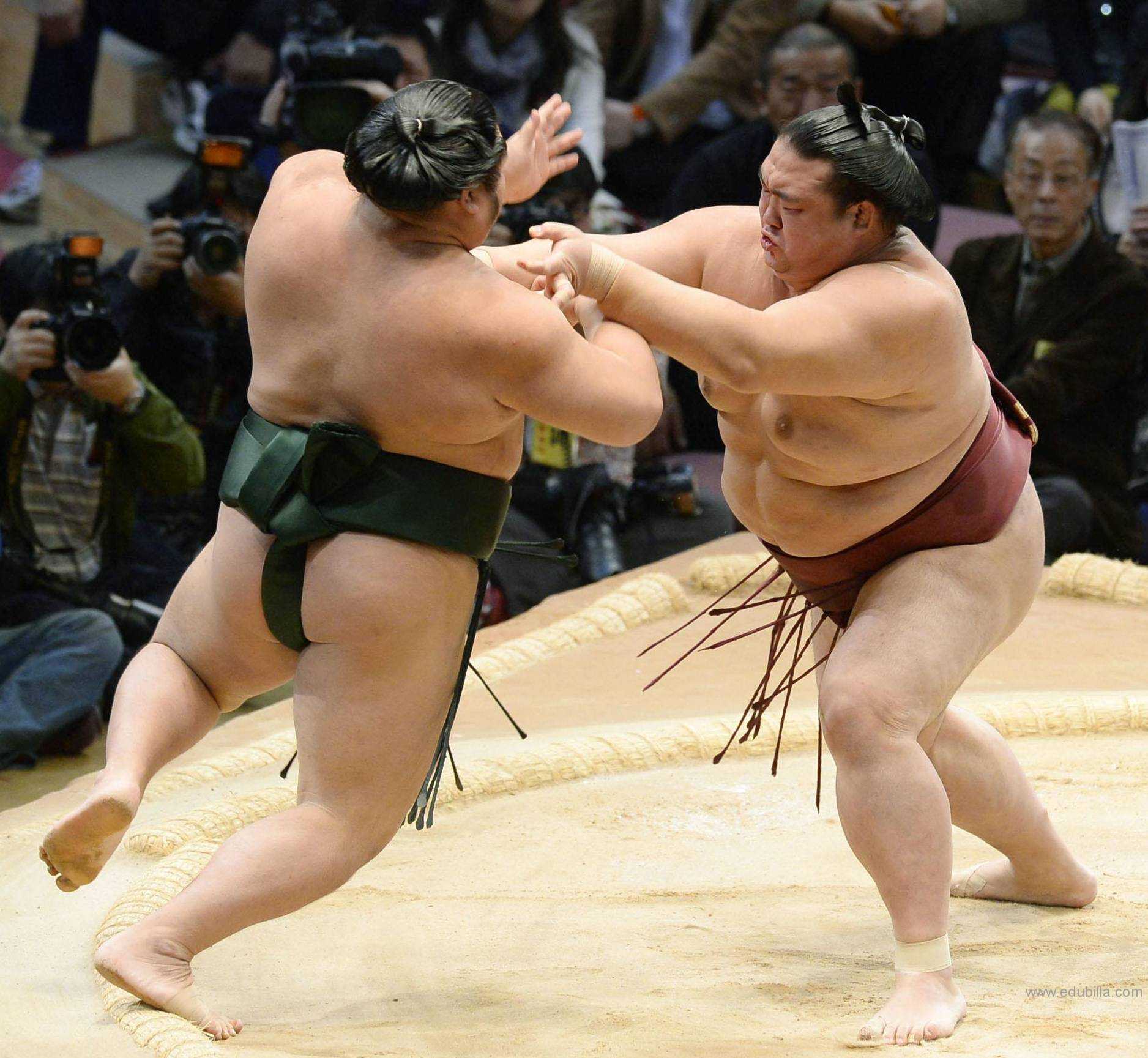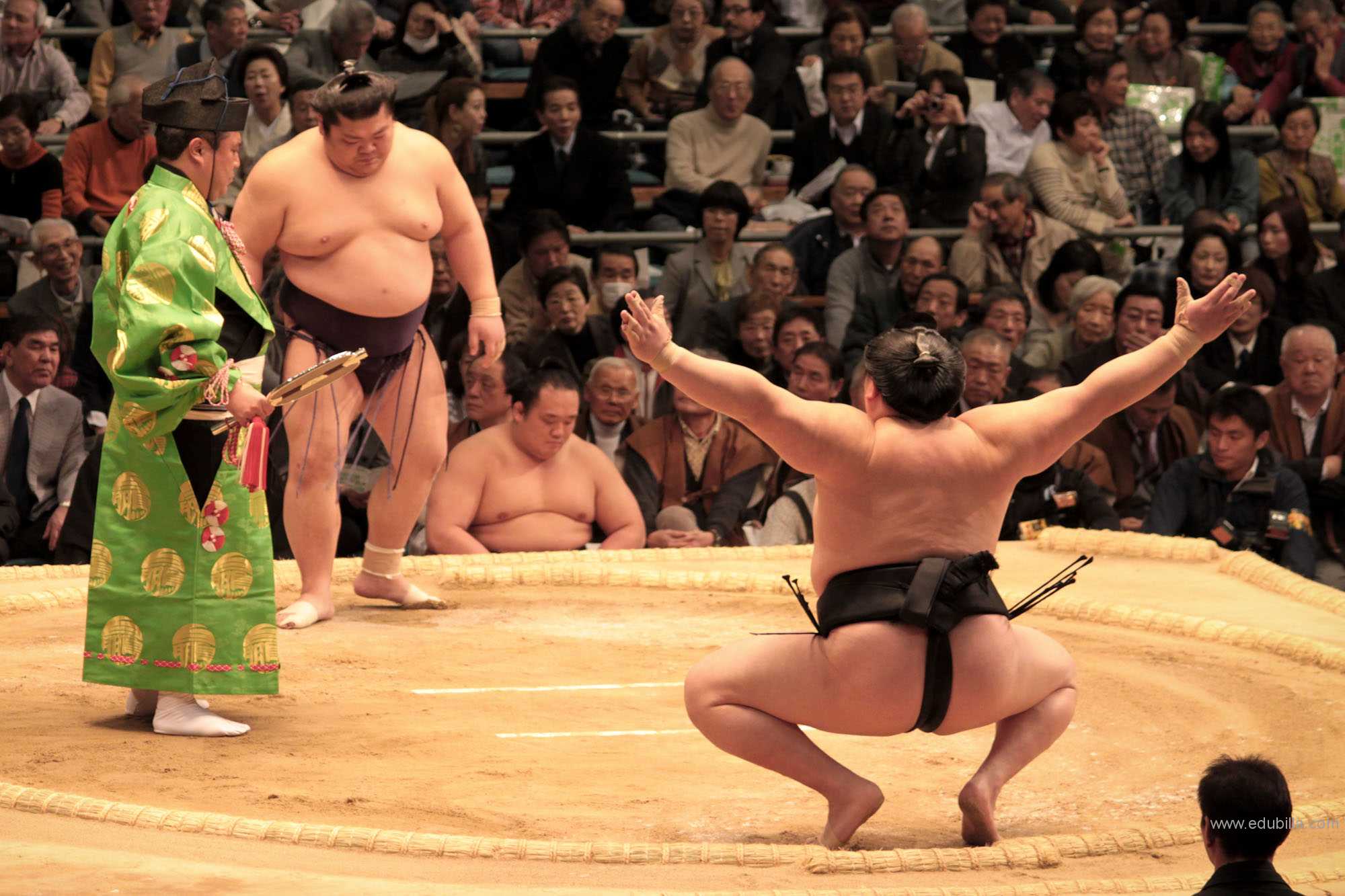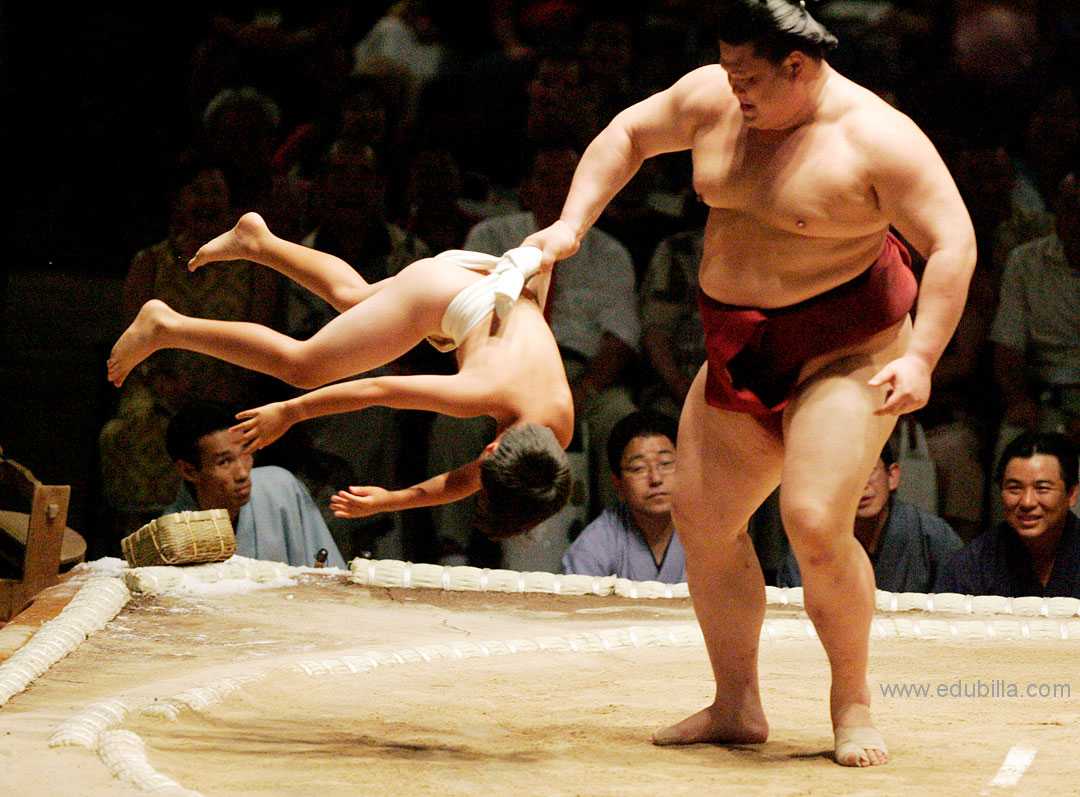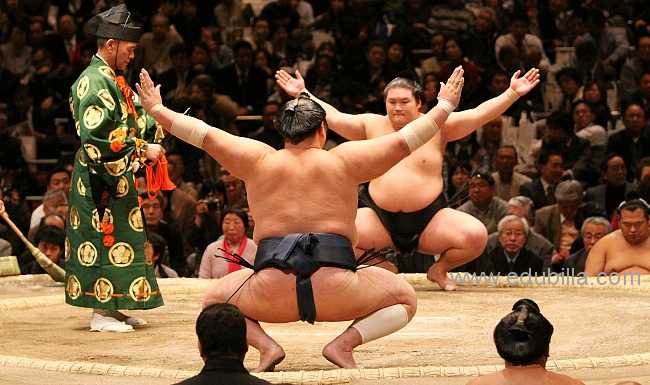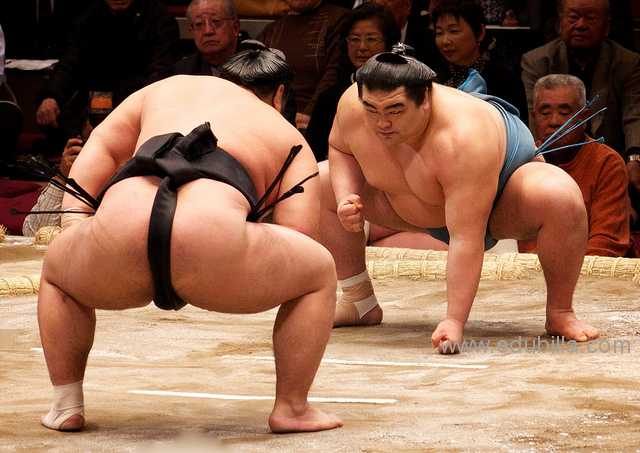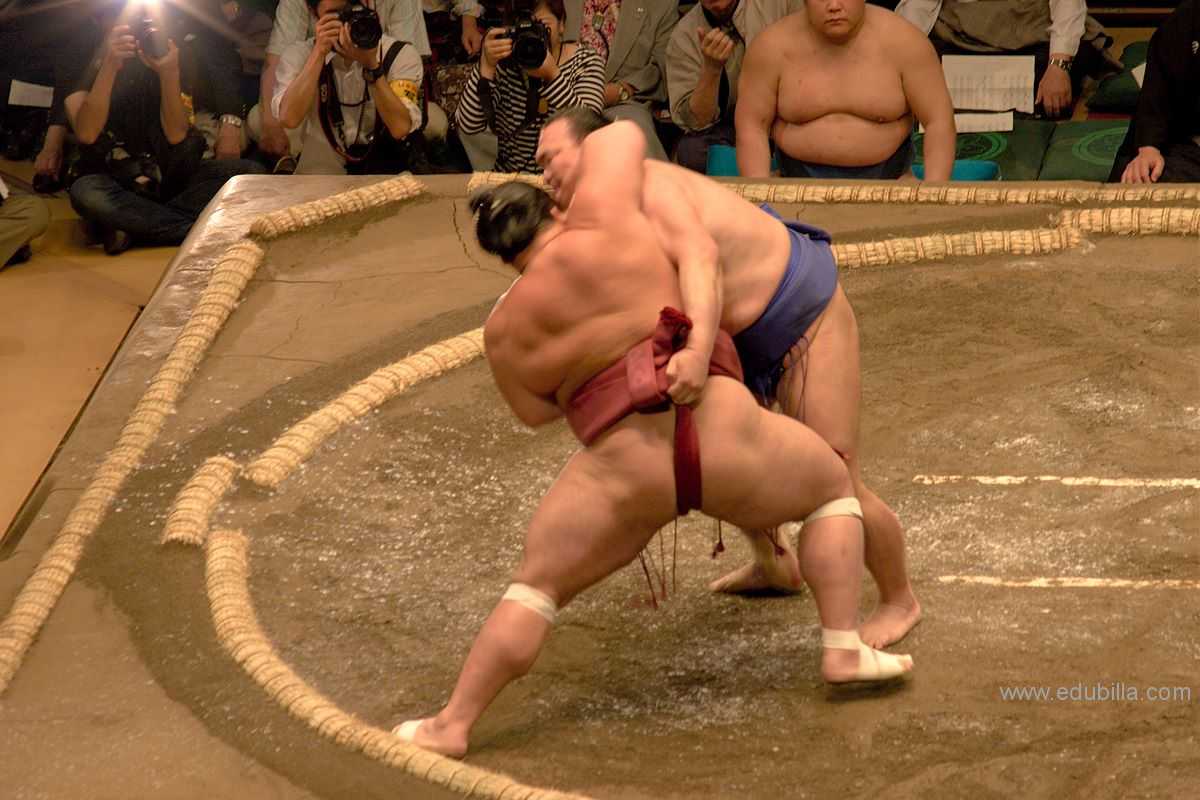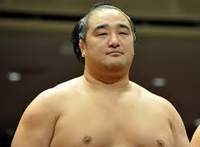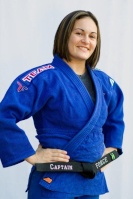
Overview Of Sumo
Sumo is a competitive full-contact wrestling sport where a rikishi (wrestler) attempts to force another wrestler out of a circular ring (dohyo) or to touch the ground with anything other than the soles of the feet. The characters ?? literally mean "striking one another".
The sport originated in Japan, the only country where it is practiced professionally. It is generally considered to be a gendai budo (a modern Japanese martial art), though this definition is misleading as the sport has a history spanning many centuries. Many ancient traditions have been preserved in sumo, and even today the sport includes many ritual elements, such as the use of salt purification, from the days when sumo was used in the Shinto religion. Life as a wrestler is highly regimented, with rules laid down by the Japan Sumo Association. Most sumo wrestlers are required to live in communal "sumo training stables", known in Japanese as heya, where all aspects of their daily lives—from meals to their manner of dress—are dictated by strict tradition.
In recent years, a number of high-profile controversies and scandals rocked the sumo world, with a concomitant effect on its reputation and ticket sales, while also affecting the sport's ability to attract new recruits.Despite this, sumo's popularity and general attendance has rebounded due to having multiple yokozuna (or grand champions) for the first time in a number of years and other high profile wrestlers such as Endo and Ichinojo grabbing the public's attention
Sumo Museum:
This small museum is located inside the Kokugikan sumo stadium. It houses rotating exhibitions about sumo, including a collection of portraits of past and present yokozuna, pictures of significant events in the history of sumo, and ceremonial aprons worn by retired prominent wrestlers. During Tokyo tournaments, the museum is only accessible to tournament ticket holders.
Ekoin Temple:
Before the first sumo stadium was built in 1909, sumo tournaments were held outdoors at Ekoin Temple, just a short walk from Ryogoku Station. Today, visitors to the temple can see a stone monument on the temple grounds that honors past wrestlers and stable masters.
Game Rules
The sport of sumo has very few rules, which can result in some exciting bouts. Sumo takes place in a ring approximately 15 feet in diameter that is raised about 2 1/2 feet off the ground on a huge block of clay called a dohyo. A light sprinkling of sand is applied inside of the ring. The edge of the ring is made of tightly wound straw bands called tawara and rises up about 3 inches out of the dohyo. A new dohyo is created for each tournament. Five judges, or shinpan dressed in black kimono, sit below the dohyo and around the ring. These judges are former rikishi themselves. A referee, or gyoji, dressed in an elaborate kimono stands at the edge of the ring and officiates the bout. At the end of the bout, the gyoji points to the winner. In a particularly close bout, any of the five judges can dispute the call made by the referee. In this case, a conference, called a mono-ii, is held inside the ring with the gyoji and five shinpan to discuss the match. In modern times, television instant replay is used to determine the actual outcome of a match when in dispute.
At the bottom of this page is the complete list of kimari-te. Close attention should be paid to the smaller rikishi, especially the Mongolians, as their small statures force them to resort to a wide variety of moves. The names of the kimari-te are usually compound words that combine two or more techniques together to explain the method used to win. Here are some of the more common compounds:
oshi = push with elbows bent
uwate = outer grip on belt
otoshi = drop
tsuki = push with elbows locked
shitate = inner grip on belt
hineri = twist
yori = lean or force with one's weight
kiri = literally to cut, or force out
k/gake = trip
okuri = send out of the ring
nage = throw
dashi = send out of the ring
soto = outside
taoshi = knock down to the ring
hiki = pull down
uchi = inside
abise-taoshi forcing one's opponent down inside the ring with the body.
ami-uchi forcing the opponent down to the ring by grabbing his arms, spreading the body out, and then pulling him down.
ashi-tori lifting the opponent's leg up forcing him to topple to the ring floor off balance.
chon-gake tipping the opponent's opposite side leg by the ankle (e.g. right leg tips right ankle) making it aloft, then pushing opponent down.
fusensho winning by default because your opponent didn't show up for the bout—usually because he is injured.
gassho-hineri gripping the opponent's head with both hands and twisting him down.
hansoku winning by default because your opponent performed an illegal maneuver.
harima-nage rear-belt throw.
hataki-komi pulling one's opponent down to the ring by the head, neck, or shoulders
hiki-otoshi pulling one's opponent down by the arms.
hikkake grabbing your opponent's arm from the inside and using the other hand to grab the opponent's other hand or arm and pulling or twisting him down.
ippon-zeoi dodging an opponent's tsuki, grabbing his stretched arm over the shoulder and hurling him over your body (this is a throw frequently seen in judo).
isami-ashi winning because your opponent accidentally stepped outside the ring while on the offensive.
izori dodging opponent's charge by crouching down, then grabbing his leg with both arms and mounting him on your back, then leaning back making him fall first.
kaina-hineri taking opponent's upper arm with one arm, placing palm of other arm from above and pressing down causing the opponent twist and turn over.
kake-nage locking one arm around the opponent while wrapping one leg around his leg, then swinging the off-balance opponent down.
kake-zori leg-kick sacrifice throw.
kata-sukashi putting one arm under the opponent's same arm (right arm to opponent's right arm, etc.) and while pulling forward slapping down on the shoulder with the other hand.
kawazu-gake in self defense wrapping a leg around the back of the opponent's leg and wrapping the arm around the opponents neck causing both to rikishi to fall back with the counter-attacker on top.
ke-kaeshi foot-sweeping the opponent's ankle and pulling him down to the ring floor.
keta-guri kicking the opponent's ankle from inside out while he is charging causing him to topple over.
kime-dashi locking both arms around the opponent's outstretched arms and driving him out of the ring.
kime-taoshi locking both arms around the opponent's outstretched arms and forcing him down to the ring floor.
kiri-kaeshi pressing the leg on the outside of your opponent's thigh and twisting his belt causing him to trip.
komata-sukui while holding the opponent's belt with one hand, using the other hand to grab his thigh while throwing with the belt hand causing him to lose his balance and topple over.
koshi-kudake winning because the opponent accidentally loses his balance and falls, usually by the hip being unable to support his shifting weight.
kosh-inage throwing your opponent after picking him up and mounting him to your waist.
kote-nage locking you arm around your opponent's arm and throwing him down.
kubi-hineri putting one hand on the opponent's neck and the other on his elbow and twisting the opponent down putting pressure on the neck.
kubi-nage curling your arm around the opponent's neck and throwing him down.
maki-otoshi wrapping your arms around the opponent's torso and twisting him down.
mitokoro-zeme putting your leg against the opponent's inner-thigh and while tripping him grabbing the back of his other knee to throw him off balance.
nicho-nage while maintaining an inner-grip on the opponent's belt, planting the leg around the opponent's opposite leg and using this as a pivot to throw him down.
nimai-geri kicking or sweeping the opponent's ankle from the outside to make him fall.
okuri-dashi pushing the turned-around opponent out of the ring from his back side.
okuri-nage throwing the opponent out of the ring with a grip on the back of his belt.
okuri-taoshi pushing the turned-around opponent down to the ring floor from his back side.
oomata lifting up the opponents inner thigh to topple him.
oshi-dashi pushing one's opponent out of the ring with both hands.
oshi-taoshi pushing one's opponent down to the ring floor with both hands.
saba-ori pulling inward on the opponents belt while leaning forward to bring him to his knees.
saka-tottari counter move by escaping the opponent's arm bar and grabbing his arm and elbow in return and twisting him down.
shitate-dashi-nage with inner-grip on opponent's belt, pulling him forward and throwing down.
shitate-hineri grabbing the opponent's front belt and twisting him down.
shitate-nage throwing opponent down with an inside grip on his belt.
shumo-kuzori crouching down, lifting up opponent high, and falling backwards to the ring.
soto-gake wrapping leg around outside of opponent's leg below the knee and tripping him.
soto-komata twisting the opponent with a grip on the belt, while scooping the other hand under the opponent's thigh to trip him off balance.
soto-muso twisting the opponent with a grip on the belt while placing the other hand behind the opponent's knee to trip him off balance.
soto-tasuki-zori clutching the opponent's arm and outer thigh, lifting him on your shoulders, and tipping him back to the ring floor.
sukubi-otoshi pushing the opponent to the ring floor by the back of the neck.
sukui-nage throwing opponent down without a grip on the belt and usually with a forearm to the armpit.
suso-harai sweeping the opponents feet from under him with the hands from the rear.
suso-tori grabbing the opponent's ankle from the outside causing him to trip.
tasuki-zori clutching the opponent's arm and thigh, lifting him on your shoulders, and tipping him back to the ring floor.
tottari grabbing opponents wrist with one hand and elbow with the other, standing to the side of opponent, and twisting his whole body around to topple him down.
tsukami-nage lifting opponent up by the belt and dropping him down.
tsuki-dashi pushing opponent out of the ring with stiff arm thrusts.
tsuki-otoshi pushing opponent down to the ring floor from the side with a stiff arm thrust, usually after side-stepping the opponent's charge.
tsuki-taoshi pushing opponent to the ring floor with alternating stiff arm thrusts.
tsuma-tori while pushing opponent from the side, grabbing his foot or ankle to cause him to fall forward.
tsuri-dashi picking one's opponent up by the belt and carrying him outside of the ring.
tsuri-otoshi picking one's opponent up by the belt and dropping him down inside the ring.
uchi-gake tripping opponent by placing leg below the knee on the inside, and pushing over.
uchi-muso twisting the opponent with a grip on the belt while pushing with the other hand on the opponent's inner-thigh to trip him off balance.
utchari counter move by placing both feet on the edge of the ring's straw, supporting opponent's weight on own torso, and twisting him out of the ring.
uwate-dashi-nage with an outer grip on the opponent's belt, simultaneously throwing him over and pushing him down.
uwate-hineri with an outer grip on the opponents belt, pulling him down to the ring floor in a twisting motion.
uwate-nage throwing opponent down with an outer grip on his belt. Takanohana, Kaio
wari-dashi maintaining an outer grip with one hand, using the other hand to press on opponents upper arm causing him to lean backwards out of the ring.
watashi-komi pulling the opponent's calf forward with one hand while pushing against his body with the other causing him to topple to the ring floor.
yagura-nage maintaining an outer grip on the belt, using the other hand to lift the opponents knee on the same side and twisting him down.
yobi-modoshi while retreating, using charging opponent's momentum to push him down.
yori-kiri forcing the opponent out of the ring from the front while maintaining a grip on the belt. Most rikishi; this is the most common kimari-te.
yori-taoshi forcing opponent to fall over backwards at the edge of the ring while maintaining a grip on his belt.
zubuneri with the opponent's head up against your chest, grabbing his elbow and twisting him down.
Equipments Need For Sumo
Dohyo -- The Wrestling Place:
The competition ring is called a dohyo. Traditionally made from rice-straw bales, the dohyo has a diameter of 4.55 meters, or about 15 feet. The circle is mounted on a square platform made of clay that is 6.7 meters across and anywhere from 34 to 60 centimeters -- about 13 to 24 inches -- high. In Japan, it is customary to construct a new dohyo before each tournament.
Mawashi -- Sumo Wrestler Garment:
A sumo wrestler's attire -- mawashi -- comes in a variety of colors and designs. Some mawashis are just straight lengths of fabric, approximately 9.1 meters -- about 30 feet -- long when unwrapped. Others have long, decorative tassels that dangle from the front. Mawashis are more than just an arbitrary garment, because in sumo you are allowed to grab your opponent by his mawashi to pull or swing him off balance. For this reason, some sumo wrestlers wear their mawashi in a particular way.
Clean Sand and Brush:
In a traditional sumo match, sand is spread over the dohyo around the outside of the ring. The sand serves a unique purpose because it allows the judges to determine if a wrestler stepped outside the ring. Since the sand is used for this purpose, it must be cleaned and finely brushed before each match so it is always clear to see if a wrestler stepped out of bounds.
Wrestling Mats:
Wresting mats are an optional piece of equipment you may need for sumo wrestling. They are not used in a professional sumo tournament, but you can lay them down over your dohyo to prevent injury. They are also handy for practicing sumo wrestling.
Novelty Equipment:
There are no stores that sell authentic dohyos, so to get your own sumo wrestling equipment you'll have to build your dohyo from raw materials. However, if you don't want to build your own dohyo, there are stores that sell and rent novelty sumo wrestling equipment, including nonregulation dohyos, sumo suits and even sumo wigs.
History Of Sumo
Historians agree that the origins of sumo date back 2000 years; however, it never really flourished as a spectator sport until the early 1600's. Like any other social group in Japan, there are strict rules and traditions that are observed throughout the sport. The beginner watching his first sumo broadcast on television soon realizes that very little time is actually spent grappling. Rather, the rikishi spend most of their time performing pre-bout ceremonies steeped in Shinto tradition.
Sumo in pre-modern Japan:
There are several other legends about sumo matches held in the imperial presence before Japan adopted the Chinese writing system in the 7th century. The first historically authenticated bout took place in 642, when Empress Kogyoku (r. 642-45) assembled her palace guards to perform sumo to entertain envoys from the Paekche court of Korea. Later records mention sumo being performed at the functions of the imperial court, including at coronation ceremonies. The custom of 'tenran-zumo' (sumo in the imperial presence) is still carried out at present, albeit in different form.
The Modern Sumo Kyokai:
The predecessor of modern professional sumo underwent an almost parallel development throughout the Edo period and was called 'kanjin-zumo,' implying that it was to be carried out to collect donations toward the construction or repair of shrines, temples, bridges and other public works. But some of the money, of course, was also used to pay the rikishi, many of whom at that time were ronin (masterless samurai). In due time the money collected came to be used primarily as wages for the sumotori.
During the Edo period a ranking system and ranking sheets were initiated. In 1761, the name of the sumo organization on the ranking sheets was changed from kanjin-zumo to 'kanjin-ozumo,' marking the first time the professional version of the sport was called 'Grand Sumo.'
Professional sumo:
Professional sumo is organized by the Japan Sumo Association.The members of the association, called oyakata, are all former wrestlers, and are the only people entitled to train new wrestlers. All practicing wrestlers are members of a training stable (or heya) run by one of the oyakata, who is the stablemaster for the wrestlers under him. Currently there are 47 training stables for about 660 wrestlers
Professional sumo tournaments:
As of 1958 there are six Grand Sumo tournaments (Japanese: honbasho) each year: three at The Sumo Hall (or Ryogoku Kokugikan) in Ryogoku, Tokyo (January, May, and September), and one each in Osaka (March), Nagoya (July) and Fukuoka (November). Each tournament begins on a Sunday and runs for 15 days, ending also on a Sunday.Each wrestler in the top two divisions (known as sekitori) has one match per day, while the lower ranked wrestlers compete in seven bouts, approximately one every two days.
Origin Of Sumo
In addition to its use as a trial of strength in combat, sumo has also been associated with Shinto ritual, and even certain shrines carry out forms of ritual dance where a human is said to wrestle with a kami (a Shinto divine spirit); see Shinto origins of sumo. It was an important ritual at the imperial court. Representatives of each province were ordered to attend the contest at the court and fight. They were required to pay for their travels themselves. The contest was known as sumai no sechie, or "sumai party."
Ancient Sumo:
The earliest written mention of sumo is found in the Kojiki (Record of Ancient Matters), a book from the year 712, which is the oldest extant example of Japanese writing. The Kojiki relates a legend about how possession of the Japanese islands was determined by a sumo match. According to the book, about 2,500 years ago, the gods Takemikazuchi and Takeminakata grappled on the shores of Izumo along the Japan Sea coast in what is now Shimane-ken, until the latter finally lost. Thus control of the archipelago was ceded to the Japanese people led by Takemikazuchi, who is said to have established the imperial family from which the present emperor traces his ancestry.
Since the Japanese didn't keep any written records until the 8th century, it is impossible to know, aside from legend, exactly when sumo first developed in Japan. However, ancient wall paintings indicate that its origins are very old indeed. In prehistoric times, sumo appears to have been performed mainly as an agricultural ritual to pray for a good harvest.
Popularity:
Over the rest of Japanese recorded history, sumo's popularity has changed according to the whims of its rulers and the need for its use as a training tool in periods of civil strife. The form of wrestling combat probably changed gradually into one where the main aim in victory was to throw one's opponent. The concept of pushing one's opponent out of a defined area came some time later.
Governing Bodies
International Sumo Federation(ISF):
The International Sumo Federation (ISF) is the largest international governing body of sport Sumo with over 87 member countries. It was formed in 1992 and is the only Sumo organization recognised by the International Olympic Committee and World Anti-Doping Agency has more than ten million members
Members:
International Sumo Federation has 87 established National sumo Federations.
Organization:
International Sumo Federation encourages the sport's development worldwide, including holding international championships. A key aim of the federation is to have Sumo recognized as an Olympic sport. Accordingly, amateur tournaments are divided into weight classes (men: Lightweight up to 85 kg (187 lb), Middleweight up to 115 kg (254 lb), Heavyweight over 115 kg (254 lb), and Open Weight), and include competitions for female wrestlers (Lightweight up to 65 kg (143 lb), Middleweight up to 80 kg (180 lb), Heavyweight over 80 kg (180 lb), and Open Weight).
Awards Related To Sumo
Sansho (sumo),literally "three prizes" are the three special prizes awarded to top (Makuuchi) division sumo wrestlers for exceptional performance during a sumo honbasho or tournament. The prizes were first awarded in November 1947.
The three prizes are
Shukun-sho, Outstanding Performance prize
Kanto-Sho (dare Dou tours), Fighting Spirit prize
Gino-Sho (skill reward), Technique prize
Typically the gino-sho is awarded to the wrestler who displays the most skillful kimarite, or techniques; the shukun-sho is awarded to a wrestler who defeats the yokozuna or the eventual tournament winner, or who otherwise displays outstanding performance relative to his rank; and the kanto-sho to the wrestler who has most clearly fought tenaciously and to the best of his abilities. The gino-sho is considered the most prestigious, and is also the prize most often not awarded at all: in 1988, it was withheld for five tournaments in a row.However each award is worth the same amount of money, two million yen.
Emperor's Cup:
The Emperor's Cup is presented to the wrestler who wins the top division makuuchi championship. Numerous other (mostly sponsored) prizes are also awarded to him. These prizes are often rather elaborate, ornate gifts, such as giant cups, decorative plates, and statuettes. Others are quite commercial, such as one trophy shaped like a giant Coca-Cola bottle.
The Emperor's Cup term is used for many national championships in other sports. Like the football prize, most of them are knockout tournaments, except for professional sumo where the trophy is awarded for winning a round-robin Grand Sumo Tournament.
Kinboshi (gold star):
Kinboshi (gold star) is a notation used in professional sumo wrestling to record a lower-ranked (maegashira) wrestler's victory over a yokozuna.
It is believed that the term stems from the usage of the terms shiroboshi (lit: white star) to designate a bout victory, and kuroboshi (black star) to designate a bout defeat. Thus, a "gold star" designates it as a special victory.
The word kinboshi first came into popular use in the Taisho period 1912-1926, and the system of monetarily awarding a maegashira who defeated a yokozuna in an official tournament began in January, 1930.
A kinboshi victory increases the balance in the maegashira's mochikyukin account by 10 yen. This balance is converted using a multiplier, presently 4,000, and added to the wrestler's bonus in every subsequent tournament in which he competes as a sekitori. With six tournaments a year, this one victory corresponds to a pay increase of 240,000 yen per annum for the remainder of the wrestler's sekitori career.
Gino sho (Technique Award):
Typically the gino-sho is awarded to the wrestler who displays the most skillful kimarite, or techniques; the shukun-sho is awarded to a wrestler who defeats the yokozuna or the eventual tournament winner, or who otherwise displays outstanding performance relative to his rank; and the kanto-sho to the wrestler who has most clearly fought tenaciously and to the best of his abilities. The gino-sho is considered the most prestigious, and is also the prize most often not awarded at all: in 1988, it was withheld for five tournaments in a row.However each award is worth the same amount of money, two million yen.
Shukun sho - (Outstanding Performance Award):
This award is given to the sumotori who has done well enough to almost get yusho (win the tournament), or who has beaten the winner of the tournament (or the yokozuna). Actually, also lower ranked wrestlers, who has not even met the yokozuna or even an ozeki, can get shukun sho if they perform exceptionally well.
Kanto sho- (Fighting Spirit Award):
This award goes to the most keen and industrious wrestler, who manages to use his abilities to his best advantage.
Sample Documents Of Sumo
-Lance Armstrong

